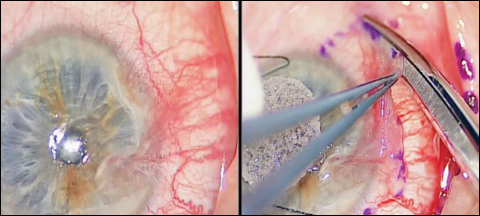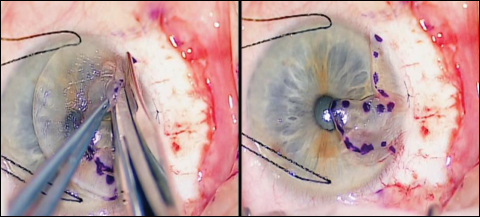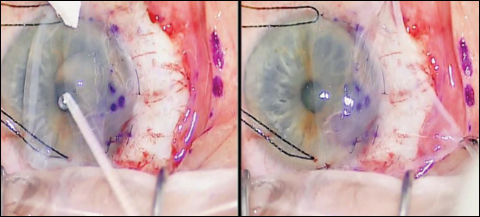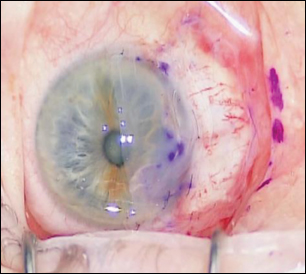Deep pterygium excision can pose surgical challenge
In this case, the surgeon also used anterior lamellar keratoplasty and cryopreserved amniotic membrane transplant.
Pterygium surgery can be challenging due to the extent of corneal involvement. In addition, postoperative recurrences can often be more difficult to manage than primary pterygium. Hence, there is a large menu of surgical techniques to choose from to optimize outcomes.
In this column, I describe a case of pterygium with deep corneal stromal involvement that requires gentle dissection especially in the areas of significant corneal stromal thinning in order to prevent intraoperative iatrogenic corneal perforation. To augment the area of recipient corneal bed thickness, an anterior lamellar keratoplasty is added to the surgical technique using an automated microkeratome and an artificial anterior chamber. This lamellar disc is then dissected to fit the recipient corneal stromal bed. It is important to shape the edges appropriately to provide a uniform, smooth surface at the margins of the donor recipient corneal tissue to provide adequate patient comfort and to facilitate uniform tear film spread to this region of the newly created ocular surface. This is complemented by covering the surface with cryopreserved amniotic membrane to facilitate healing while minimizing inflammation.
Surgical technique
The anesthesia for the procedure may be monitored anesthesia care or general anesthesia, depending on patient and surgeon preference. The pterygium in this case involves the paracentral region of the cornea and is invading the deep corneal stroma (Figure 1). By blunt and sharp dissection, the pterygium is excised, and the underlying bare sclera is exposed (Figure 1). Due to the deep corneal stromal involvement, the pterygium is not being peeled off the cornea to prevent any damage to the underlying thin corneal stromal bed; instead, it is gently dissected from the corneal stroma (Figure 2).

Images: John T









The cut edges of the conjunctiva are attached to the episcleral tissue using 10-0 interrupted Vicryl sutures (Figure 3). There is significant corneal stromal loss in the region of the pterygium that was removed, showing marked corneal thinning (curved arrow) (Figure 3). Hemostasis is achieved using a hand-held disposable cautery (Figure 3).
The donor cornea is then mounted onto an artificial anterior chamber, and a lamellar corneal disc is excised using an automated microkeratome while keeping the surface moist with sterile balanced salt solution (Figure 4). The donor lamellar disc is seen on the disposable microkeratome head (Figure 5). A sterile marking pen is used to demarcate the area of lamellar tissue dissection to match the recipient corneal bed (Figure 5). The lamellar graft is shaped to match the corneal stromal defect in the recipient bed (Figure 6). The donor lamellar graft is attached to the recipient corneal bed using Tisseel fibrin glue (Baxter) (Figure 7). Cryopreserved amniotic membrane (Bio-Tissue) is attached to the corneal and scleral surface using Tisseel fibrin glue (Figure 8). A muscle hook is used to iron the surface of the amniotic membrane for uniform attachment (Figure 9). Figure 10 shows the completed view of the procedure.
- References:
- Cornelius CR. Cornea. 2017;doi:10.1097/ICO.0000000000001026.
- Genidy MM, et al. Eur J Ophthalmol. 2017;doi:10.5301/ejo.5000946.
- Hara T, et al. Graefes Arch Clin Exp Ophthalmol. 2017;doi:10.1007/s00417-016-3558-9.
- Jirsova K, et al. Cell Tissue Bank. 2017;doi:10.1007/s10561-017-9618-5.
- Park J, et al. Can J Ophthalmol. 2016;doi:10.1016/j.jcjo.2016.05.004.
- Shusko A, et al. Can J Ophthalmol. 2016;doi:10.1016/j.jcjo.2016.02.022.
- For more information:
- Thomas “TJ” John, MD, a clinical associate professor at Loyola University at Chicago and in private practice in Oak Brook, Tinley Park and Oak Lawn, Ill., can be reached at email: tjcornea@gmail.com.
Disclosure: John reports he is a consultant to, is on the speakers bureau of and has a stock interest in Bio-Tissue.
